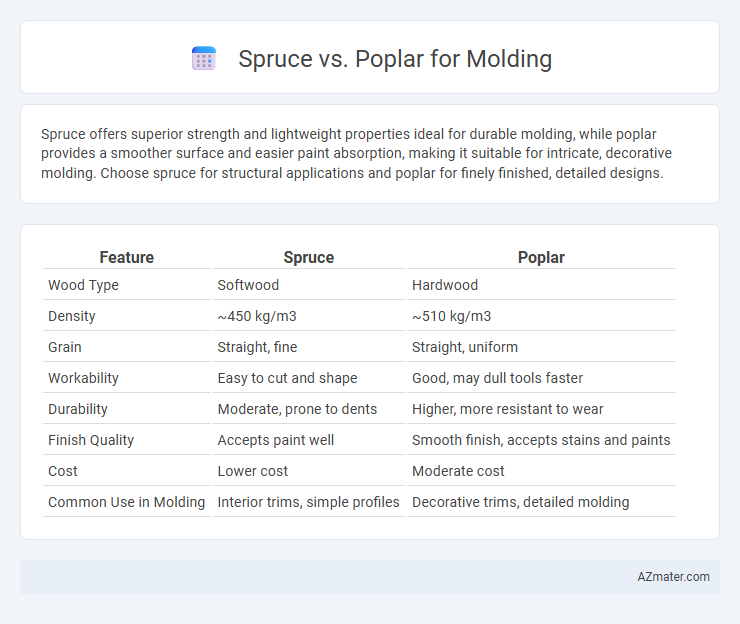Spruce offers superior strength and lightweight properties ideal for durable molding, while poplar provides a smoother surface and easier paint absorption, making it suitable for intricate, decorative molding. Choose spruce for structural applications and poplar for finely finished, detailed designs.
Table of Comparison
| Feature | Spruce | Poplar |
|---|---|---|
| Wood Type | Softwood | Hardwood |
| Density | ~450 kg/m3 | ~510 kg/m3 |
| Grain | Straight, fine | Straight, uniform |
| Workability | Easy to cut and shape | Good, may dull tools faster |
| Durability | Moderate, prone to dents | Higher, more resistant to wear |
| Finish Quality | Accepts paint well | Smooth finish, accepts stains and paints |
| Cost | Lower cost | Moderate cost |
| Common Use in Molding | Interior trims, simple profiles | Decorative trims, detailed molding |
Introduction to Spruce and Poplar for Molding
Spruce and poplar are popular wood choices for molding due to their unique properties and cost-effectiveness. Spruce offers a lightweight, softwood option with a fine, straight grain ideal for smooth, paintable surfaces, while poplar, a hardwood, provides superior durability and a consistent texture suitable for staining or painting. Both woods are widely used in interior molding applications, balancing aesthetic appeal with functional performance.
Wood Characteristics: Spruce vs Poplar
Spruce exhibits a straight grain with a light color and uniform texture, making it ideal for molding requiring strength and a smooth finish. Poplar features a fine, even texture with a softer, pale cream to greenish hue, offering easier workability and good paint adhesion for decorative molding. The hardness of poplar is generally lower than spruce, influencing durability and suitability depending on molding applications.
Workability and Machining Properties
Spruce offers excellent workability and machining properties due to its soft texture and uniform grain, making it easy to shape and finish for detailed molding projects. Poplar, though slightly harder than spruce, machines cleanly with minimal splintering and holds paint well, providing a smooth surface ideal for primed or painted moldings. Both woods are lightweight and stable, but spruce's ease of cutting and sanding makes it preferable for intricate profiles, while poplar's fine grain supports a high-quality finish after machining.
Durability and Strength Comparison
Spruce molding offers moderate strength with a lightweight structure, making it suitable for interior applications where ease of installation is prioritized. Poplar, while slightly heavier, provides greater durability and resistance to wear, making it ideal for areas subject to frequent contact or impact. The higher density and hardness of poplar ensure longer-lasting molding with less susceptibility to dents and scratches compared to spruce.
Finishing Qualities and Paint Absorption
Spruce offers a smooth surface that absorbs paint evenly, making it ideal for detailed molding projects requiring a consistent finish. Poplar features a fine grain and uniform texture, allowing it to take paint well with minimal blotching, resulting in a clean, professional look. Both woods perform well in finishing, but Poplar's superior paint absorption properties make it the preferred choice for high-quality painted moldings.
Cost Analysis: Spruce vs Poplar
Spruce molding generally costs less than poplar due to its abundance and faster growth rate, making it a budget-friendly choice for large projects. Poplar, while slightly more expensive, offers superior paintability and smoother finish, which can reduce additional finishing costs. Factoring in both initial price and finishing expenses, spruce provides the best value for cost-conscious buyers, whereas poplar is ideal for higher-end, detailed molding applications.
Environmental Impact and Sustainability
Spruce molding offers a lower environmental footprint due to its fast growth rate and abundant availability in North America, supporting sustainable forestry practices. Poplar, known for rapid growth and efficient carbon sequestration, provides an eco-friendly option with minimal waste during processing, enhancing its sustainability profile. Both woods contribute to reduced deforestation when sourced from responsibly managed forests, but Spruce's widespread natural abundance often makes it a more sustainable choice for environmentally-conscious molding projects.
Recommended Applications for Molding
Spruce is recommended for interior molding due to its lightweight nature and straight grain, providing smooth finishes ideal for decorative trim and window casings. Poplar is favored for painted molding applications because of its fine, uniform texture and ease of machining, making it perfect for baseboards and chair rails that require a clean, paint-ready surface. Both woods offer cost-effective solutions but choose spruce for natural wood finishes and poplar for versatile, paintable moldings.
Pros and Cons of Spruce and Poplar
Spruce offers lightweight strength and affordability, making it ideal for intricate molding designs, but it tends to have a softer grain that dents and wears more easily compared to hardwoods. Poplar provides a smoother surface and superior paint adhesion with its fine grain, yet it is less durable for high-traffic areas and may show dents and scratches faster. Selecting between spruce and poplar depends on balancing budget constraints with desired durability and finish quality in molding applications.
Final Verdict: Choosing the Right Wood for Molding
Spruce offers lightweight durability with a straight grain, making it ideal for intricate molding designs, while poplar provides a smoother finish and better paint adhesion due to its fine texture. For projects emphasizing cost-effectiveness and ease of painting, poplar stands out as the preferred choice, whereas spruce suits applications requiring natural wood aesthetics and stability. Consider the specific project needs--painted or stained finish, durability, and grain preference--to select the optimal wood for molding.

Infographic: Spruce vs Poplar for Molding
 azmater.com
azmater.com